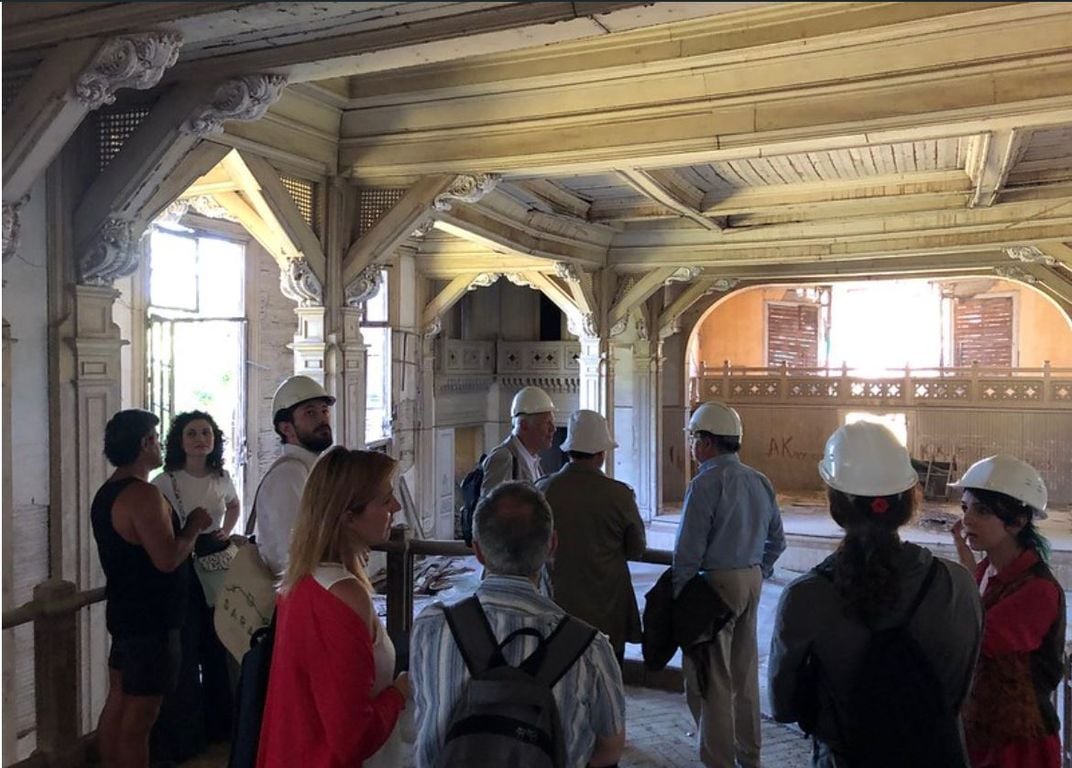Preservationists Rally to Save Abandoned Casino-Turned-Orphanage in Istanbul
The enormous, 122-year-old structure—one of Europe’s largest wooden buildings—is close to collapsing
:focal(516x292:517x293)/https://tf-cmsv2-smithsonianmag-media.s3.amazonaws.com/filer/f8/ec/f8ec061d-d994-4d04-bf41-8bcdced528ca/orphanage.jpg)
One of the world’s largest wooden buildings, Turkey’s Prinkipo Orphanage, could be rescued from rot and decay and transformed into an environmental research center, reports Ayla Jean Yackley for the Art Newspaper.
Heritage organization Europa Nostra lists the 122-year-old building as one of the continent’s most threatened cultural sites. Located on the Princes’ Islands off the coast of Istanbul in the Mediterranean Sea, it was originally intended to act as a luxury hotel and casino. Per Atlas Obscura, architect Alexander Vallaury designed the venue in 1898 on behalf of the Compagnie Internationale des Wagons-Lits, the train company that operated the Orient Express. But plans to open the business fell apart when Abdul Hamid II, sultan of the Ottoman Empire, forbade gambling on religious grounds and prevented the casino from opening.
In 1903, the wife of a rich banker bought the unused building and donated it to the Eastern Orthodox Church’s Ecumenical Patriarchate of Constantinople, which, in turn, turned the space into an orphanage. The 215,000-square-foot building housed up to 1,000 boys at a time, serving almost 6,000 in total over the next 60 years. In 1964, the orphanage was forced to close due to mounting tensions between Turkey and Greece.
The property’s physical structure has been in decline ever since. As Despina Karpathiou reports for Greek City Times, it was badly damaged in a 1980 fire; in 1997, the Turkish state seized the property, but 13 years later, the European Court of Human Rights ordered its return to the Ecumenical Patriarchate.
The enormous six-story building, sometimes known as the Büyükada Rum Orphanage Istanbul, features about 220 rooms, including a ballroom with balconies and boxes, elaborately carved wooden columns, and decorative paneled ceilings. Depending on how terms are defined, it competes with the Metropol Parasol in Spain for the title of the largest wooden building in Europe. Today, sections of the structure’s roof have caved in, and rain has destroyed some of its floors.
“You cannot find another timber structure built with these techniques on this scale from that period still standing, which makes this building so significant,” Burcin Altinsay, chair of Europa Nostra Turkey, tells the Art Newspaper.

Writing for Hurriyet Daily News, Ariana Ferentinou describes seeing the devastated state of the once-grand building when she visited it in 2018.
“The last schoolteacher who saw the closure of the school and the orphanage in 1964 had difficulty in holding his tears while trying to describe to me the joy of teaching in these exquisite surroundings,” she writes.
Last year, Europa Nostra and the European Investment Bank Institute issued a report detailing damage to the building, as well as the work needed to rehabilitate it and its cultural value.
“The Orphanage is of significance to the mythology of the island and holds a special place in the shared memory of the local communities, especially in the minds of the Rum (Greek) community of İstanbul,” the report stated.
Per the findings, the cost of stopping the building’s deterioration and restoring it to safe conditions would be almost €2 million ($2.4 million). The report estimated the minimum cost of fully rehabilitating the structure at €40 million and predicted that it would take four to five years to complete the project.
The report suggested that the building be reconfigured as an “Environmental and Inter-faith Dialogue Centre, free from any political agenda.” But it also acknowledged that other uses might be desirable and could help generate revenue to make the project financially viable.
As the site’s owner, the Patriarchate, is responsible for raising the money and organizing the project. Since the report’s publication, the group has been working with other interested parties to develop a plan. Representative Laki Vingas tells the Art Newspaper that the effort will depend on the success of a fundraising effort planned for next year. Assuming it is successful, the project could move forward in 2022.
“The orphanage has had a painful history,” Vingas says. “But it is part of Istanbul’s legacy, and our community has a responsibility to safeguard it. We cannot lose this building, and so we will find a way to keep it alive.”
/https://tf-cmsv2-smithsonianmag-media.s3.amazonaws.com/accounts/headshot/Livia_lg_thumbnail.png)
/https://tf-cmsv2-smithsonianmag-media.s3.amazonaws.com/accounts/headshot/Livia_lg_thumbnail.png)